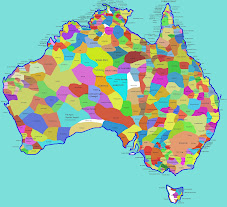An Overview of Yolngu Matha Language Characteristics
The only detailed examination of Yolngu Matha morphology was made by Frances Morphy, and published in "The Handbook of Australian Languages" in 1983. To do this, Morphy looked at Djapu, one of the Yolngu Matha dialects, as a representative example.
Djapu has 19 consonants and, like most Australian languages, three vowels. Words must begin with a consonant but can end with either a vowel or a consonant, and stress is primarily on the first syllable.
Djapu utilizes verbs, adverbs, demonstratives, personal and interrogative pronouns, and nominals. Nominals are divided into humans and higher animates, and lower animates or inanimates. There are singular, dual and plural number personal pronouns in the first and third person, but in the second person there are only singular and non-singular. Interrogative pronouns and determiners inflect to convey ergative or absolutive case, while personal pronouns are nominative or accusative.
Here are some sentences in Djapu:
dhuwal guya luka-nha-mirr
this fish eat is able
this fish is edible
guya-puy dhuwal dhäwu
fish-is about this story
this story is about fish
dhuwal miditjin wapiti-wuy
this medicine stingray-is for
this medicine is for [curing] stingray [wounds]
Djadaw’marama is a word that literally means to make the sun come up, but its actual meaning is to staying up all night.
Yolngu Matha has an SOV word order. It lacks front rounded vowels, glottalized and uvular consonants, and fricatives. Yolngu languages are suffixing and are isolated from other Pama-Nyungan languages by the Aboriginal peoples of the surrounding areas that speak prefixing languages of other Australian genera.
Yolngu Matha exhibits reduplication - the morphological phenomenon of repeating the full or partial root of a word in order to convey grammatical information, like plurality, or to create new words. When this phenomenon occurs frequently throughout the language, linguists call this "productive" usage.
Yolngu Matha has dependent-marking in clauses and possessive noun phrases. Grammatically, dependent marking is the mark that shows how different parts of a phrase will be put on the modifiers as opposed to the heads. The head of a phrase is the main noun. The dependents are the adjectives, articles, and possessives.
Here is an audio file of a story being told in Yolngu Matha:
http://www.ards.com.au/aud_story_turtles.htm
Djapu has 19 consonants and, like most Australian languages, three vowels. Words must begin with a consonant but can end with either a vowel or a consonant, and stress is primarily on the first syllable.
Djapu utilizes verbs, adverbs, demonstratives, personal and interrogative pronouns, and nominals. Nominals are divided into humans and higher animates, and lower animates or inanimates. There are singular, dual and plural number personal pronouns in the first and third person, but in the second person there are only singular and non-singular. Interrogative pronouns and determiners inflect to convey ergative or absolutive case, while personal pronouns are nominative or accusative.
Here are some sentences in Djapu:
dhuwal guya luka-nha-mirr
this fish eat is able
this fish is edible
guya-puy dhuwal dhäwu
fish-is about this story
this story is about fish
dhuwal miditjin wapiti-wuy
this medicine stingray-is for
this medicine is for [curing] stingray [wounds]
Djadaw’marama is a word that literally means to make the sun come up, but its actual meaning is to staying up all night.
Yolngu Matha has an SOV word order. It lacks front rounded vowels, glottalized and uvular consonants, and fricatives. Yolngu languages are suffixing and are isolated from other Pama-Nyungan languages by the Aboriginal peoples of the surrounding areas that speak prefixing languages of other Australian genera.
Yolngu Matha exhibits reduplication - the morphological phenomenon of repeating the full or partial root of a word in order to convey grammatical information, like plurality, or to create new words. When this phenomenon occurs frequently throughout the language, linguists call this "productive" usage.
Yolngu Matha has dependent-marking in clauses and possessive noun phrases. Grammatically, dependent marking is the mark that shows how different parts of a phrase will be put on the modifiers as opposed to the heads. The head of a phrase is the main noun. The dependents are the adjectives, articles, and possessives.
Here is an audio file of a story being told in Yolngu Matha:
http://www.ards.com.au/aud_story_turtles.htm










